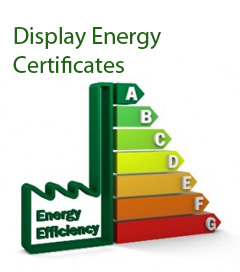Whereas an EPC reflects the energy efficiency of the building fabric and the systems, Display Energy Certificates (DECs) reflects how efficiently the energy is used in the building. DECs are required for public buildings over 1000m2 in area and need to be produced every year. The certificate needs to be displayed in a prominent place in the building so that visitors can easily see it. The Certificate reports on the previous three years so that improvements in energy use can readily be seen on a year on year basis.
Energy Assessors will be accredited by Sterling to undertake DECs and the accompanying Advisory Report that provides the building owner/user with information on how improvements can be made.
The Sterling Accreditation Scheme, and the processes that support it, have been developed to provide Assessors with the support they need to ensure a consistently high quality product. They will be provided with a comprehensive membership package and all the support they need to operate in a fast moving and highly technical area.
DEC requirements
This guide describes the obligations that come into force for buildings occupied by a public authority where, from 9 July 2015, the total useful floor area of the building exceeds 250m2 and which is frequently visited by the public.
Why DECs are required
The purpose of introducing DECs is to raise public awareness of energy use and to inform visitors to public buildings about the energy use of a building. DECs provide an energy rating of the building from A to G, where A is very efficient and G is the least efficient and are based on the actual amount of metered energy used by the building over the last 12 months within the validity period of the DEC.
An affected organisation must display a DEC in a prominent place clearly visible to the public and have in its possession or control a valid advisory report. The advisory report contains recommendations for improving the energy performance of the building.
Buildings requiring a DEC
A DEC and advisory report are required for buildings with a total useful floor area (see definitions at Annex B) over 250m2 that are occupied in whole or part by public authorities and frequently visited by the public.
For the purposes of the regulations, a building is defined as, ‘a roofed construction having walls, for which energy is used to condition the indoor climate, and a reference to a building includes a reference to a part of a building which has been designed or altered to be used separately’[footnote 1].
For a building to fall within the requirement for a DEC it must:
- have a roof and walls; and
- use energy to condition the indoor climate. This is the case where the building has any of the following fixed services: heating, mechanical ventilation or air conditioning
A building can either be:
- the whole of a building; or
- part of a building, where the part is designed or altered to be used separately
Only buildings, with a total useful floor area greater than 250m2, occupied by a public authority and frequently visited by the public are affected by this legislation.
Private organisations, including those that may share a building with a relevant institution, do not need to display a DEC, but may elect to do so on a voluntary basis.
When DECs are required
From 9 January 2013, if you are an occupier of a building requiring a DEC, you will need to display a DEC showing an operational rating in a prominent place clearly visible to the public. You will also need to have in your possession or control a valid advisory report.
If you are a new occupier, or have been in occupation for less than 15 months by 9 January 2013, you may not have the previous 12 months of meter readings available that are required for an operational rating. The legislation makes provisions for calculation over the period of occupation in these cases.
Validity period of DECs
Where the building has a total useful floor area of more than 1,000m2, the DEC is valid for 12 months. The accompanying advisory report is valid for 7 years. Where the building has a total useful floor area of between 250m2 and 1000m2, the DEC and advisory report are valid for 10 years.
What a DEC contains
A DEC must contain, by law, the following information:
- the operational rating as determined by the government approved operational rating methodology
- a reference value such as a current legal standard or benchmark
For buildings with a total useful floor area greater than 1000m2 only, the DEC must also contain:
- the operational ratings for the building expressed in any certificates displayed by the occupier during the last 2 years before the nominated date. In buildings where no historic energy consumption data are available, this information will not be complete until the third year of occupation after the introduction of DECs for that type of building as it will be derived from previous DECs
The DEC will also show the unique certificate reference number under which the DEC has been registered, the address of the building, the total useful floor area of the building, the name and address of the energy assessor, the name of their accreditation scheme and the date when the DEC was issued.
What an advisory report contains
The advisory report accompanies the DEC and contains recommendations for improving the energy performance of the building. The advisory report may contain a range of possible improvements, including cost effective measures that may be implemented to improve the energy performance of the property. The report includes zero and low cost operational and management improvements, possible upgrades to the building fabric or services, and opportunities for the installation of low and zero carbon (LZC) technologies.
The report enables the occupier to identify what may be done to improve, for example, building energy management, building services, etc. therefore reducing energy consumption and CO2 emissions.
The advisory report categorises the list of recommendations, by payback period as follows:
- short term payback (up to 3 years), for example building energy management measures
- medium term payback (3 to 7 years), for example upgrading building services
- long term payback (more than 7 years), for example low and zero carbon technologies
- each category includes the energy assessor’s selection of the most suitable improvement measures for the building, generally between 5 and 10 measures. The advisory report also includes the energy assessor’s recommendations which may include additional improvement measures, for example measures recommended by a previous energy audit
- the advice provided in the advisory report is intended to be for information only. Occupiers receiving an advisory report are advised to seek further detailed professional advice before reaching any decision on how to improve the energy performance of the building.






